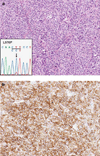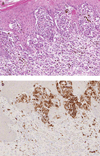Correlation between KIT expression and KIT mutation in melanoma: a study of 173 cases with emphasis on the acral-lentiginous/mucosal type
- PMID: 19718013
- PMCID: PMC4120323
- DOI: 10.1038/modpathol.2009.116
Correlation between KIT expression and KIT mutation in melanoma: a study of 173 cases with emphasis on the acral-lentiginous/mucosal type
Abstract
The role of immunohistochemistry in the assessment of KIT status in melanomas, especially acral lentiginous/mucosal, is not well established. Although the reported prevalence of KIT mutations in acral lentiginous/mucosal melanomas is relatively low, detection of mutations in KIT can have profound therapeutic implications. We evaluated the efficacy of immunohistochemistry to predict mutations in KIT. One hundred seventy-three tumors, comprising primary and metastatic melanomas (141 acral lentiginous/mucosal, 5 nodular, 4 lentigo maligna, 3 superficial spreading, 2 uveal, 1 melanoma of soft parts, 8 metastases from unclassified primaries, and 9 metastases from unknown primaries) were studied. Immunohistochemical expression of KIT using an anti-CD117 antibody and KIT mutational analysis by gene sequencing of exons 11, 13, and 17 were performed. Eighty-one percent of acral lentiginous/mucosal melanomas, primary and metastatic, showed KIT expression by at least 5% of the tumor cells. The overall frequency of activating KIT gene mutations in acral lentiginous/mucosal melanomas was 15% (14 out of 91 cases), being the L576P mutation in exon 11 the most frequently detected (4 of 14 cases). Cases showing less than 10% positive tumor cells were negative for KIT mutations. Eighty-two percent (12 of 14) of cases positive for KIT mutation showed KIT expression in more than 50% of the cells. An association between immunohistochemical expression of KIT and mutation status was found (P=0.007). Immunohistochemical expression of KIT in less than 10% of the cells of the invasive component of acral lentiginous/mucosal melanomas appears to be a strong negative predictor of KIT mutation and therefore can potentially be used to triage cases for additional KIT genotyping.
Conflict of interest statement
The authors declare no conflict of interest.
Figures



Similar articles
-
KIT amplification and gene mutations in acral/mucosal melanoma in Korea.APMIS. 2011 Jun;119(6):330-5. doi: 10.1111/j.1600-0463.2011.02737.x. Epub 2011 Mar 24. APMIS. 2011. PMID: 21569090
-
Analysis of KIT expression and gene mutation in human acral melanoma: with a comparison between primary tumors and corresponding metastases/recurrences.Hum Pathol. 2013 Aug;44(8):1472-8. doi: 10.1016/j.humpath.2013.01.007. Epub 2013 Mar 22. Hum Pathol. 2013. PMID: 23528861
-
KIT gene mutations and copy number in melanoma subtypes.Clin Cancer Res. 2008 Nov 1;14(21):6821-8. doi: 10.1158/1078-0432.CCR-08-0575. Clin Cancer Res. 2008. PMID: 18980976
-
c-Kit inhibitors for unresectable or metastatic mucosal, acral or chronically sun-damaged melanoma: a systematic review and one-arm meta-analysis.Eur J Cancer. 2021 Nov;157:348-357. doi: 10.1016/j.ejca.2021.08.015. Epub 2021 Sep 22. Eur J Cancer. 2021. PMID: 34562816
-
The clinical significance of KIT mutations in melanoma: a meta-analysis.Melanoma Res. 2018 Aug;28(4):259-270. doi: 10.1097/CMR.0000000000000454. Melanoma Res. 2018. PMID: 29746316 Review.
Cited by
-
Melanoma biology and treatment: a review of novel regulated cell death-based approaches.Cancer Cell Int. 2024 Feb 9;24(1):63. doi: 10.1186/s12935-024-03220-9. Cancer Cell Int. 2024. PMID: 38336727 Free PMC article. Review.
-
Morpho-Molecular Assessment Indicates New Prognostic Aspects and Personalized Therapeutic Options in Sinonasal Melanoma.Cancers (Basel). 2019 Sep 7;11(9):1329. doi: 10.3390/cancers11091329. Cancers (Basel). 2019. PMID: 31500314 Free PMC article.
-
Efficacy and safety of nilotinib in patients with KIT-mutated metastatic or inoperable melanoma: final results from the global, single-arm, phase II TEAM trial.Ann Oncol. 2017 Jun 1;28(6):1380-1387. doi: 10.1093/annonc/mdx079. Ann Oncol. 2017. PMID: 28327988 Free PMC article. Clinical Trial.
-
Acral Melanoma: A Review of Its Pathogenesis, Progression, and Management.Biomolecules. 2025 Jan 14;15(1):120. doi: 10.3390/biom15010120. Biomolecules. 2025. PMID: 39858514 Free PMC article. Review.
-
Acral Melanoma in Skin of Color: Current Insights and Future Directions: A Narrative Review.Cancers (Basel). 2025 Jan 30;17(3):468. doi: 10.3390/cancers17030468. Cancers (Basel). 2025. PMID: 39941835 Free PMC article. Review.
References
-
- Grichnik JM, Burch JA, Burchette J, et al. The SCF/KIT pathway plays a critical role in the control of normal human melanocyte homeostasis. J Invest Dermatol. 1998;111:233–238. - PubMed
-
- Grichnik JM. Kit and melanocyte migration. J Invest Dermatol. 2006;126:945–947. - PubMed
-
- Holden JA, Willmore-Payne C, Layfield LJ. Tyrosine kinase activating mutations in human malignancies: implications for diagnostic pathology. Exp Mol Pathol. 2008;85:68–75. - PubMed
-
- Alexeev V, Yoon K. Distinctive role of the cKit receptor tyrosine kinase signaling in mammalian melanocytes. J Invest Dermatol. 2006;126:1102–1110. - PubMed
-
- Natali PG, Nicotra MR, Winkler AB, et al. Progression of human cutaneous melanoma is associated with loss of expression of c-kit proto-oncogene receptor. Int J Cancer. 1992;52:197–201. - PubMed
MeSH terms
Substances
Grants and funding
LinkOut - more resources
Full Text Sources
Medical

